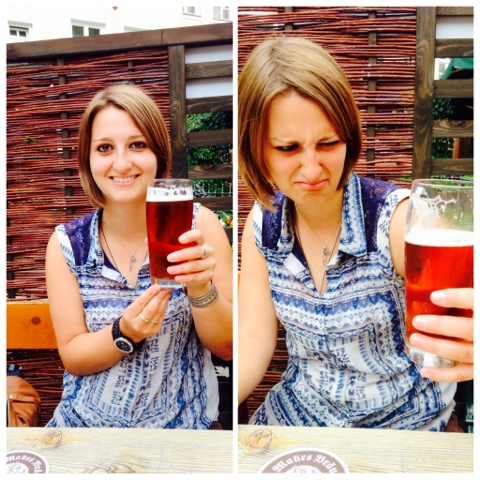We decided to visit the semi famous wall of John Lennon, which was used for political messages during the 1980s and has now mainly degraded into the usual 'Shaz was here' graffiti. The Segway tours which gave out little spray paint cans to their group was especially amusing. I did rather like the googely-eyed snail at the top however.
Our next stop was an extremely attractive art nouveau 'Municipal House' which is now home to a theatre. Although one had to go on a guided tour to see if properly, we were able to peek into the bar which looked like something out of a 20s gangster film.
One of the annoyances of Prague were the Segway tour guides who would zoom towards you like eager bats of of hell, trying to get you to go on their tours. It was extremely annoying, though slightly amusing.
After all walking in the heat, we decided to stop for a well deserved lunch. Our foray into Italian food proved to be a great one, with delicious pizza, prettily wrapped napkins and a waiter that reminded me of a Polish Bond villain. We had our lovely lunch with cold homemade lemonade - this was one of my favourite quirks of Prague - most places had their own take on freshly made lemonade, sometimes in different flavours too, like raspberry! It was a huge step up from the usual average Sprite one could expect to be served.
We finished off the brilliant experience asking for the dessert menu, upon which our dastardly waiter brought a large stamp around and stamped our tablecloth (made of paper) with a rather stylish dessert menu. We of course all had tiramisu, which proved excellent.
Stuffed with good Italian food, we headed for the shade in the Prague city museum. This building held an eclectic collection including a huge detailed model of the city of Prague during the 1700s, some buildings still in construction. My favourite collection however was on barbarians and their burials. After the 5th century burial practices changed from cremation to inhumation (a common trend across Europe) the subsequent burial evidence is fascinating. The picture below features a child's burial.
Locks during the medival times were ridiculously large and complicated, and almost seemed an art form in themselves, the more ornate the better. This one was stupendously large!
As we headed out we were drawn by the distant sound of cheering. I assumed it was some sort of music festival but as we headed closer we discovered -much to Yannick's delight - it was in fact a mini basketball game!
Our last stop was a somber affair. The church of Saint Cyrel and Methoduis was the spot of the last resistance of the ten Czech paratroopers who dared to defy Nazi occupied Czechsolvakia. In an operation assisted by London innocently called 'operation Anthropoid' the soldiers were trained to assinate the Nazi officer newly in charge of the police, Reinhard Heydrich. Although they succeeded, it had devastating consequences. After the deed was done, they fled to this church and successfully hid in the crypt, until they were betrayed. In a fierce last stand (the photo on the left shows the spray of bullets that riddled the church's walls) they fought in the crypt until they were killed in the battle or commitee suicide to avoid capture. Not one survived.
Retribution was swift, and any person who had contact or sheltered these fighters were murdered, including their entire family down to the last child - from the priests who sheltered them in their church, to a girl seen leading the bicycle away that one of the members had arrived on.
Our walk on the way back to the campsite afforded us this pretty view.
























































